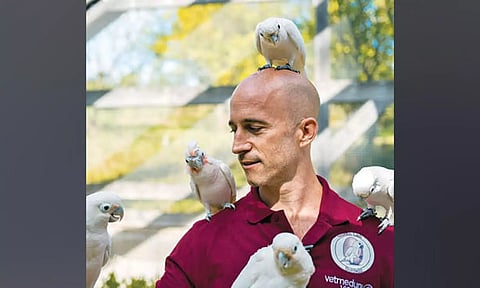

• EMILY ANTHES
NEW YORK: Every day, the Goffin Lab in Vienna offers the same luncheon to its patrons. At 2 p.m., the diners — a flock of white parrots known as Goffin’s cockatoos — receive an assortment of dried fruit, seeds, cornflakes, bird pellets and a dry, twice-baked toast known as rusk or zwieback. It’s a perfectly palatable meal for a parrot, and most birds dig right in. But a few of the cockatoos are more discriminating, customizing their meals with one final flourish: Before eating the rock-hard rusk, they dunk it in a tub of water.
Although the gesture is familiar to biscotti lovers with opposable thumbs, for the Goffin’s cockatoo, the behavior appears to be an innovation in food preparation, researchers reported in a study published Tuesday in the journal Biology Letters. The cockatoos sometimes devoted considerable time and energy to the task, actively transporting the rusk to water and then waiting for it to soften.
“To go through all this effort just to change the texture of your food is quite impressive,” said Alice Auersperg, the head of the Goffin Lab at the University of Veterinary Medicine Vienna and an author of the study. It is the first time that this food-dunking behavior has been documented in parrots — it has also been observed in grackles and crows. And it was a serendipitous discovery for the lab, which typically relies on meticulously planned experiments to test the cockatoos’ renowned problem-solving skills. “But sometimes we get gifted with accidental things that just happen,” Dr. Auersperg said.
Goffin’s cockatoos are known for their ability to use and manipulate objects. In earlier studies, Dr. Auersperg and her colleagues found, for instance, that the birds could open locked puzzle boxes and make their own tools to obtain out-of-reach food.
But the researchers at the Goffin Lab did not typically pay close attention to the birds’ behavior at lunch, said Jeroen Zewald, a doctoral student in the lab and another author of the study. Until, one day last summer, they noticed something curious. An affectionate male bird named Pipin — “the gentleman of the group,” Zewald said — was dunking his food into the tub of water typically used for drinking and bathing. Two other birds in the lab, Kiwi and Muki, turned out to be dunkers, too, the researchers noticed.
To study the behavior more systematically, Zewald and Dr. Auersperg spent 12 days observing the birds’ lunchtime behaviors. In total, seven of the 18 birds were observed dunking food at least once, they found. (Still, Pipin, Kiwi and Muki were the undisputed dunkmasters, racking up many more “dunking events” than the other birds.)
But the birds didn’t dunk all of their food. They never dunked seeds and only occasionally slipped a banana or coconut chip into the water. Instead, when the cockatoos decided to dunk something, it was almost always rusk. (Pipin and Kiwi, in fact, almost never ate it dry.)
Some birds gave the rusk a quick dunk, but others soaked it for 30 seconds or more, long enough to give the toast a soggy bottom. A delay as long as 30 seconds is notable for a bird that’s feeling peckish. “They were willing to wait for it to soak,” Zewald said. “And that takes a lot of impulse control.”